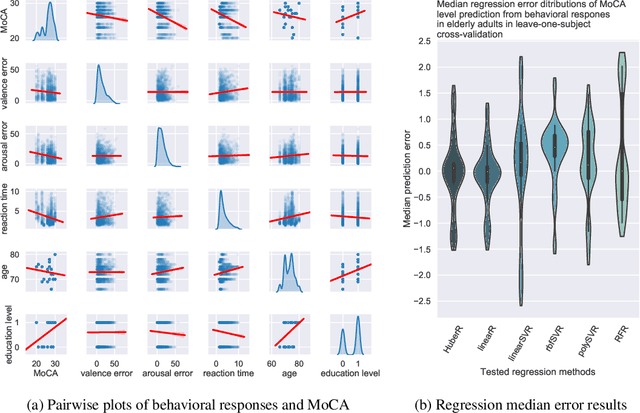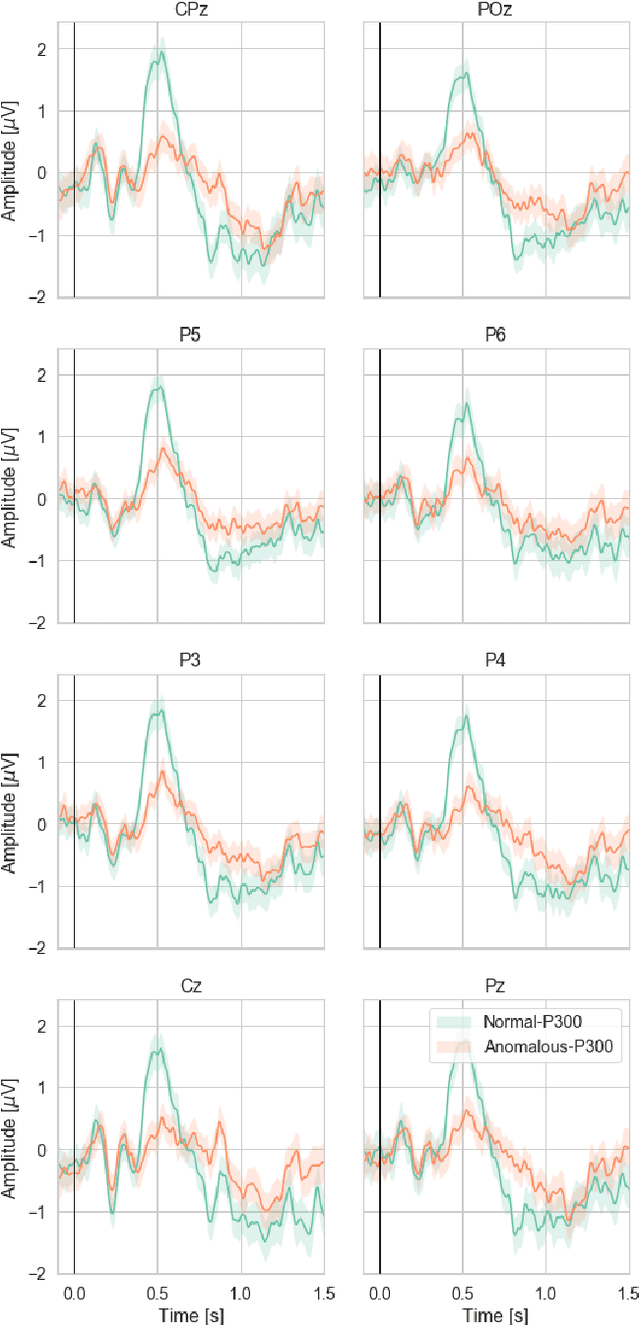Mihoko Otake-Matsuura
Early Detection of Cognitive Impairment in Elderly using a Passive FPVS-EEG BCI and Machine Learning -- Extended Version
Apr 15, 2025Abstract:Early dementia diagnosis requires biomarkers sensitive to both structural and functional brain changes. While structural neuroimaging biomarkers have progressed significantly, objective functional biomarkers of early cognitive decline remain a critical unmet need. Current cognitive assessments often rely on behavioral responses, making them susceptible to factors like effort, practice effects, and educational background, thereby hindering early and accurate detection. This work introduces a novel approach, leveraging a lightweight convolutional neural network (CNN) to infer cognitive impairment levels directly from electroencephalography (EEG) data. Critically, this method employs a passive fast periodic visual stimulation (FPVS) paradigm, eliminating the need for explicit behavioral responses or task comprehension from the participant. This passive approach provides an objective measure of working memory function, independent of confounding factors inherent in active cognitive tasks, and offers a promising new avenue for early and unbiased detection of cognitive decline.
Voice Over Body? Older Adults' Reactions to Robot and Voice Assistant Facilitators of Group Conversation
Dec 08, 2022Abstract:Intelligent agents have great potential as facilitators of group conversation among older adults. However, little is known about how to design agents for this purpose and user group, especially in terms of agent embodiment. To this end, we conducted a mixed methods study of older adults' reactions to voice and body in a group conversation facilitation agent. Two agent forms with the same underlying artificial intelligence (AI) and voice system were compared: a humanoid robot and a voice assistant. One preliminary study (total n=24) and one experimental study comparing voice and body morphologies (n=36) were conducted with older adults and an experienced human facilitator. Findings revealed that the artificiality of the agent, regardless of its form, was beneficial for the socially uncomfortable task of conversation facilitation. Even so, talkative personality types had a poorer experience with the "bodied" robot version. Design implications and supplementary reactions, especially to agent voice, are also discussed.
* Published in IJSR
Crossing the Tepper Line: An Emerging Ontology for Describing the Dynamic Sociality of Embodied AI
Mar 15, 2021

Abstract:Artificial intelligences (AI) are increasingly being embodied and embedded in the world to carry out tasks and support decision-making with and for people. Robots, recommender systems, voice assistants, virtual humans - do these disparate types of embodied AI have something in common? Here we show how they can manifest as "socially embodied AI." We define this as the state that embodied AI "circumstantially" take on within interactive contexts when perceived as both social and agentic by people. We offer a working ontology that describes how embodied AI can dynamically transition into socially embodied AI. We propose an ontological heuristic for describing the threshold: the Tepper line. We reinforce our theoretical work with expert insights from a card sort workshop. We end with two case studies to illustrate the dynamic and contextual nature of this heuristic.
Cognitive Assessment Estimation from Behavioral Responses in Emotional Faces Evaluation Task -- AI Regression Approach for Dementia Onset Prediction in Aging Societies
Nov 25, 2019
Abstract:We present a practical health-theme machine learning (ML) application concerning `AI for social good' domain for `Producing Good Outcomes' track. In particular, the solution is concerning the problem of a potential elderly adult dementia onset prediction in aging societies. The paper discusses our attempt and encouraging preliminary study results of behavioral responses analysis in a working memory-based emotional evaluation experiment. We focus on the development of digital biomarkers for dementia progress detection and monitoring. We present a behavioral data collection concept for a subsequent AI-based application together with a range of regression encouraging results of Montreal Cognitive Assessment (MoCA) scores in the leave-one-subject-out cross-validation setup. The regressor input variables include experimental subject's emotional valence and arousal recognition responses, as well as reaction times, together with self-reported education levels and ages, obtained from a group of twenty older adults taking part in the reported data collection project. The presented results showcase the potential social benefits of artificial intelligence application for elderly and establish a step forward to develop ML approaches, for the subsequent application of simple behavioral objective testing for dementia onset diagnostics replacing subjective MoCA.
Brain correlates of task-load and dementia elucidation with tensor machine learning using oddball BCI paradigm
Jun 19, 2019
Abstract:Dementia in the elderly has recently become the most usual cause of cognitive decline. The proliferation of dementia cases in aging societies creates a remarkable economic as well as medical problems in many communities worldwide. A recently published report by The World Health Organization (WHO) estimates that about 47 million people are suffering from dementia-related neurocognitive declines worldwide. The number of dementia cases is predicted by 2050 to triple, which requires the creation of an AI-based technology application to support interventions with early screening for subsequent mental wellbeing checking as well as preservation with digital-pharma (the so-called beyond a pill) therapeutical approaches. We present an attempt and exploratory results of brain signal (EEG) classification to establish digital biomarkers for dementia stage elucidation. We discuss a comparison of various machine learning approaches for automatic event-related potentials (ERPs) classification of a high and low task-load sound stimulus recognition. These ERPs are similar to those in dementia. The proposed winning method using tensor-based machine learning in a deep fully connected neural network setting is a step forward to develop AI-based approaches for a subsequent application for subjective- and mild-cognitive impairment (SCI and MCI) diagnostics.
 Add to Chrome
Add to Chrome Add to Firefox
Add to Firefox Add to Edge
Add to Edge